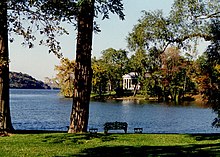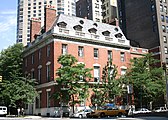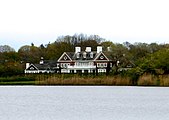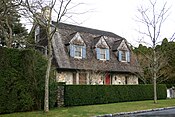Michael Dwyer is an American architect and author of books about architecture, including Great Houses of the Hudson River (2001) and Carolands (2006).
Michael Dwyer | |
|---|---|
 Garden Pavilion on the Hudson River at Barrytown, New York | |
| Born | 1954 Philadelphia, PA, USA |
| Nationality | American |
| Alma mater | Rose Bay Secondary College, Sydney, New South Wales; Columbia College (B.A.); University of Pennsylvania (M.Architecture) |
| Occupation | Architect |
| Buildings | Edgewater Pavilion |
1981–1996 (Buttrick White & Burtis)
Michael Dwyer was associated from 1981 to 1996 with the New York architecture firm Buttrick White & Burtis where he helped design several notable projects, including the Saint Thomas Choir School (completed 1987), a fifteen story boarding school in Midtown Manhattan,[1][2] described by architecture critic Paul Goldberger as "among the city's best examples of contextual architecture;"[3] and the Dana Discovery Center (completed 1993), a venue for environmental education, the centerpiece of the Central Park Conservancy's 1990–93 restoration of Harlem Meer in Central Park's northeast corner.[4][5] In a 1993 interview with the journal Progressive Architecture, Dwyer explained that the building's "picturesque character" was intended to reinforce the park's "romantic landscape design."[6][4]
Classical revival
While at Buttrick White & Burtis, Dwyer was an advocate of New York's prewar, classical style of architecture and a protagonist of its resuscitation. In a 1995 review by The New York Times of architecture's nascent classical revival, reporter Patricia Leigh Brown noted that, "Michael Dwyer...an architect at Buttrick White & Burtis...has recently completed a classical-style yacht" and a "town house on the Upper East Side,"[7] a house whose new facade Robert A.M. Stern, Dean of Yale's School of Architecture, characterized as "scholarly...reflecting the elegant manner of Ange-Jacques Gabriel."[8]
Interviewed by Brown for the article, Stern opined that the young classicists were "perhaps the true radicals of their time," whereas architect James Stewart Polshek, formerly Dean of Columbia University's School of Architecture called them "bizarrely backward" and "luddites" who were "lacking new ideas." Asked to weigh in, Yale historian Vincent Scully declared that "classicism speaks fundamentally to what people want, to security and dignity and permanence."[7]
1996–present (Michael Dwyer, Architect)
In 1996, having established his own firm, Dwyer was chosen to be the architect for the Eleanor Roosevelt Monument in New York's Riverside Park, where he supplemented landscape architect Kelly and Varnell's circular oak bosque and Penelope Jencks' bronze statue of Roosevelt with granite medallions set into the surrounding bluestone paving (one inscribed with a quotation from a 1958 speech of Roosevelt's; the other with a quotation from Adlai Stevenson's 1962 eulogy for her).[9][10]
In 1997, he restored the exterior of the Francis F. Palmer House, completed in 1918 to the design of architects Delano and Aldrich, one of New York City's designated landmarks and one of its more splendid houses.
From 1998 to 2007, he was the consulting architect to the Cosmopolitan Club, a private social club for women, helping to restore its clubhouse, designed by architect Thomas Harlan Ellett, and winner of the Architecture League's gold medal in 1933.
In addition to these institutional projects, Dwyer prepared designsfor New York's private sector, including apartments on Manhattan's east side (960 Fifth Avenue, 720 Park Avenue, and River House); its west side (The Dakota, The El Dorado, and The San Remo); and houses in diverse locations such as East Hampton, Greenwich, and Nantucket.
Edgewater
The financier and preservationist Dick Jenrette, who called Dwyer his "favorite young neoclassical architect," commissioned him to build a pair of classical pavilions at Edgewater, Jenrette's villa on the Hudson River. Jenrette described them in his memoir, Adventures with Old Houses:
In recent years, I've begun making more of my own architectural imprint on the Edgewater property. This past year I added a small neo-classical guest house, built on a point of land across the lagoon to the north of Edgewater—far enough away not to compete with the main house. Designed by Michael Dwyer of New York, the guest house is a small Grecian temple with four columns of the Doric order framing a large porch looking downriver. Viewed from the front porch of Edgewater across the lagoon, the new structure serves as an architectural folly extending the sweep of the landscape to the north.
Michael Dwyer also relocated the swimming pool and added a charming pool house, again in classical style with four Doric columns along the side of the pool. The effect is quite Roman—rather like a small corner of Hadrian's Villa. From guest house to pool house and back to the main house provides a scenic one-mile roundabout walk, mostly along the winding riverbank.[11]
Hollyhock
The July 2018 issue of Architectural Digest featured Hollyhock, a new house in Southampton, New York designed by Dwyer for real estate executive Mary Ann Tighe, a decade long collaboration with interior designer Bunny Williams, reminiscent of the prewar houses of architect David Adler and interior designer Frances Elkins. The principal rooms of the main wing include an entrance hall leading to a suite of high-studded rooms: a dining room decorated with panels of 19th-century wall paper, a living room with boiserie painted a "rich watery blue," and a 55-foot-long library divided into three spaces by projecting bookcases. The principal feature of the entrance hall is an elliptical staircase (loosely inspired by a stair designed by Adler, which in turn was inspired by a stair designed by architect John Russell Pope) to which Dwyer added a black and white starburst marble floor.[12][13]
In Hollyhock's garden, designed by Quincy Hammond in the grande manière and intended to extend the architecture of the house across the four acre landscape, Dwyer added a guest house (a kind of modern-day Petit Trianon), a garden pavilion in the form of an orangerie, an arbor with eight salvaged limestone columns supporting teak lattice panels, and a garage building in the guise of a caretaker's cottage. The tile roofs and stucco facades of all the buildings allude to Red Maples, a house designed by the architects Hiss and Weekes, with gardens designed by Ferruccio Vitale, that stood on the site from 1913 until its demolition in 1947.[12][13]
Representative projects
- 35 Meter Cruising Yacht (interior architecture; completed 1994).[14]
- Nureyev Apartment; The Dakota, New York City (interior architecture; completed 1995).[7]
- Eleanor Roosevelt Monument, Riverside Park, New York City (granite medallions and bronze plaques; completed 1996).[15]
- Windsong; Shimmo Beach, Nantucket, MA (new house; completed 1996).
- Francis F. Palmer House, 75 E 93rd St, New York City (roof replacement and window restoration; completed 1997).[16]
- Edgewater, Barrytown, NY (Garden Pavilion and Pool House; completed 1997).[17]
- Maisonette duplex, 960 Fifth Avenue, New York City (interior architecture; completed 1999).[18]
- Longview; 27 Gin Lane, Southampton, NY (new garden facade, new wing with indoor pool, and interior architecture throughout; completed 2000).[19]
- Mead Point; Indian Field Road, Greenwich, CT (new house; completed 2001).[20]
- Stone Cottage; Toylsome Place, Southampton, NY (new house and interior architecture; completed 2004).
- 720 Park Avenue, New York City (apartment alterations; completed 2006).[21]
- Cosmopolitan Club, New York City (alterations to the entrance hall, ballroom, and garden penthouse, from 1998 to 2007).
- New Sommariva; East Hampton, NY (new house; completed 2009).
- Hollyhock; Southampton, NY (new residence, guest house, garden pavilion, and arbor; completed 2017).[12][13]
- Triplex penthouse; The San Remo, New York City (alterations completed 2017).[22]
Gallery
- Frances F. Palmer house, New York City.
- Riverside facade of the Garden Pavilion at Edgewater (photo by James Hogarty).
- Tripartite window at the Garden Pavilion at Edgewater (photo by James Hogarty).
- Entrance facade of the Garden Pavilion at Edgewater (photo by James Hogarty).
- Pool House at Edgewater.
- Longview, on Lake Agawam, in Southampton, New York.
- Stone Cottage, in Southampton, New York.
- New Sommariva, in East Hampton, New York.
Bibliography
Publications (as contributor)
- Carl A. Pearson (author); Michael Dwyer (illustrator). "Up in Central Park on the Shore of Harlem Meer," Architectural Record (March 1990).
- Mark Alden Branch (author); Michael Dwyer (illustrator). "Flirting with Folly in Central Park," Progressive Architecture (August 1991): 23.
- Michael Dwyer (contributing illustrator). "A View of the Dana Discovery Center, Central Park, New York," Architecture in Perspective No. 8 (American Society of Architectural Illustrators, 1994): 10.
- Michael Dwyer (author). "Buildings in Public Parks," Clem Labine's Traditional Building (March/April 1995): 26, 28, 30; ISSN 0898-0284.
- Michael Dwyer (contributing illustrator). "New Master Plan - Trinity School," Architecture in Perspective No. 11 (American Society of Architectural Illustrators, 1996): 83.
- Michael Dwyer (author). "Building with Stone," Clem Labine's Traditional Building (March/April 1996): 25–26; ISSN 0898-0284.
- Michael Dwyer (author). "The Arts and Crafts in Architecture Today," Classicist No. 3 (1996–97): 90–96; ISBN 1-56000-936-5.
- Michael Dwyer (editor) with a preface by Mark Rockefeller. Great Houses of the Hudson River (Boston: Little, Brown and Company, in association with Historic Hudson Valley, 2001).
- Michael Dwyer (author) with a foreword by Mario Buatta. Carolands (Redwood City, CA: San Mateo County Historical Association, 2006).
Publications (as subject)
- Clem Labine, "A Townhouse in the Corinthian Order," Clem Labine's Traditional Building (September/October 1991): 48, 49; ISSN 0898-0284.
- Lee Goff, "Manhattan Townhouse," Stone Built (New York: Monacelli, 1997): 40. ISBN 9781885254696.
- Richard H. Jenrette, Adventures with Old Houses (Charleston: Wyrick, 2000): 8, 105, 161. ISBN 0-941711-46-3.
- Dan Shaw, "Top Tier Design Team Breathes Elegance into a Southampton Estate," Architectural Digest (July 2018).
- Bunny Williams, "Hollyhock," Love Affairs with Houses (New York: Abrams, 2019):13-35. ISBN 9781419734649.
Relatives
Dwyer's brother, Dr. Edward M. Dwyer, was the Director of Cardiology at St. Luke's-Roosevelt Hospital from 1978 to 1995. His sister Sharon Tozzi was for many years manager of a cattle ranch in Amado, Arizona for Whitney heiress Joan Payson and her daughter Payne Middleton. His cousin, Maj. Gen. Robert J. Dwyer was the Adjutant General of Nevada from 1983 to 1986.
See also
References
External links








